Galapagos Conservancy President, Dr. Paul Salaman, stressed the importance to continue the joint work with the GNPD. Veronica Santamaria (Director of Public Spaces for the Park), said that it was an honor to participate in events such as this, where the Galapagos Islands conservation efforts are acknowledged. She stated that the collaborative management model has been a model for other countries and that they need the support to maintain the health of the Galapagos ecosystems.
Veronica also reported on progress made toward the Galapagos National Park’s first Visitor Center. This will be completed in 2023, with support from Galapagos Conservancy. The Center will be accessible to all ages and circumstances, and it will be situated next to the Symbol of Hope Hall where Lonesome George can also be seen. Through interactive 3D panels, visitors will gain a better understanding of conservation expeditions undertaken by park rangers or their aides,” Veronica explained.
In his remarks, Dr. Jorge Carrion (Director of Conservation for Conservando Galapagos) highlighted the efforts made by the Ecuadorian Government. He also thanked donors for their support. These conservation allies are vital for the preservation of Galapagos biodiversity. Galapagos Conservancy is forever grateful to all those who support conservation efforts in the Archipelago.
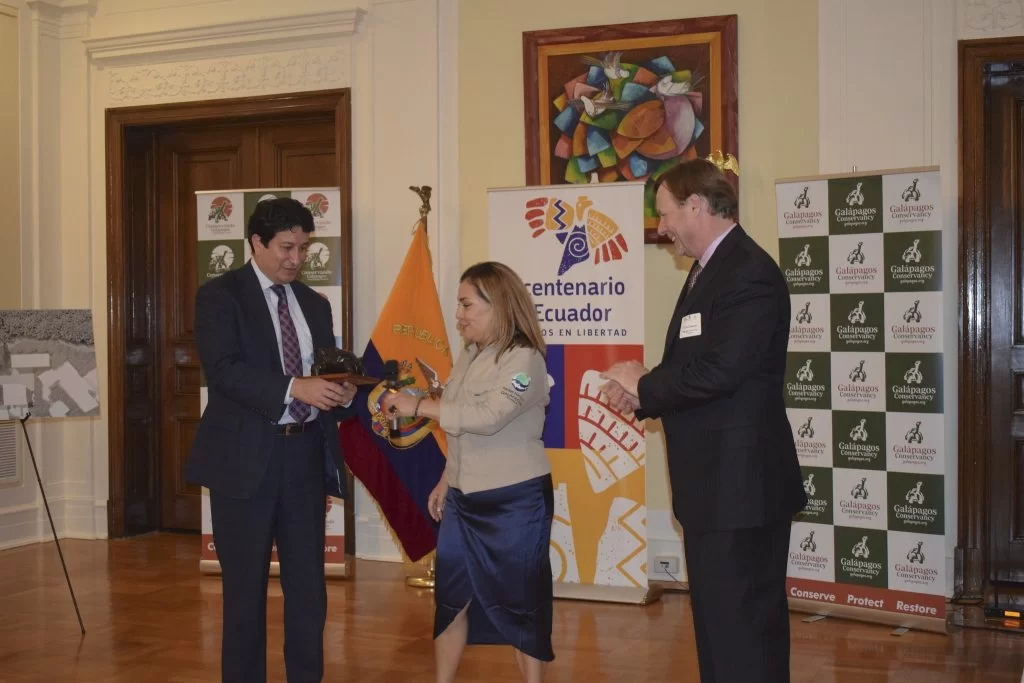
Embassy Event 2022 © Ecuadorian Embassy in DC
Pablo Escarabay is a young Galapagos resident who was a beneficiary of a Galapagos Conservancy Action Grant and began an intense search for the Vermilion Flycatchers after people reported seeing them in the wild.
He was able to form a solid research team with Diana Calderon. Pablo stated that they are organizing daily group hikes and conducting frequent search camps to find the Vermillion Flycatcher. We are optimistic as there have been reports of sightings of the iconic Galapagos bird.
To attract the witch-bird, the team uses modern technology such as acoustic recordings that record bird sounds and are placed in search areas’ trees. To capture film evidence, they have placed camera traps at strategic locations. Pablo emphasizes that the community, particularly the San Cristobal farm owners, must participate in the identification and capture of search areas. Their support is crucial to this process.
The camera traps have captured many species of birds, including flycatchers and finches, as well as owls and Smooth-billed Ani. They all seem to be attracted by the sounds of birdsong.
Experts recommend identifying strategic areas that provide the Vermilion flycatcher with ideal habitat. These areas should be identified by farm owners who have reported sightings of the animal in recent years. Pablo said, “We will continue to exhaust every resource and effort to corroborate these sightings. In the meantime we remain optimistic that the San Cristobal Vermilion Flycatcher won’t [remain] on the list of extinct species.”
The Galapagos Vermilion Flycatcher is an endemic species. There are two subspecies. One, San Cristobal has been declared extinct by IUCN. Another, a. This bird can be found on more than ten Archipelago islands, apart from San Cristobal. Unfortunately, it has suffered a rapid decline and has been designated as vulnerable by IUCN.
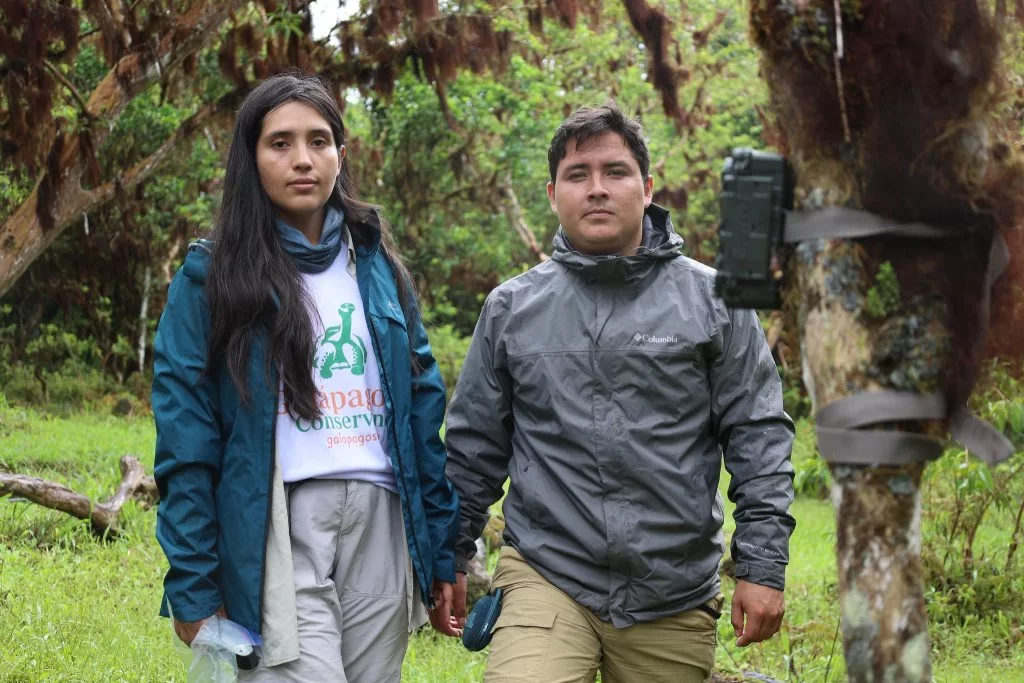
Pablo Escarabay and Diana Calderón searching for Vermilion Flycatcher © Galápagos Conservancy
Galapagos Conservancy was honored to support the ABG’s work and congratulate the 171 dedicated professionals and staff members at its 10th anniversary celebrations on Santa Cruz Island. Washington Tapia (General Director of Conservando Galapagos), an affiliate of Galapagos Conservancy spoke at the anniversary ceremony. He stated that the ABG was an indispensable institution in order to ensure the preservation of Galapagos biodiversity. Invasive species are complex problems that require constant attention.
The ABG was created by presidential decree in October 2012 and is now attached to the Environmental Ministry. Its mission is to regulate, prevent, reduce, and control the risk of exotic organisms entering, migrating, or dispersing in Galapagos by all means that could endanger the economy and human health.
Galapagos Conservancy has reached an agreement with the ABG to strengthen control measures and prevent the spread of the Giant African Snail (). This snail was introduced in 2010. It is one of the most dangerous introduced species. It can cause serious damage to crops and can transmit meningitis-causing parasites. “We cooperated in delivering two canines that are specialized for inspection and control to strengthen the canine brigade. This was done in order to increase efforts against Giant African Snails. Tapia stated that this includes training and training five ABG officers to guide the dogs.
Tapia said that the world is focused on Galapagos conservation. “Here, we find a high level of endemism, leading this archipelago be considered as a major natural treasure site for humanity.” We congratulate all ABG members for their outstanding efforts to preserve Galapagos biodiversity, and to contribute to its local population.
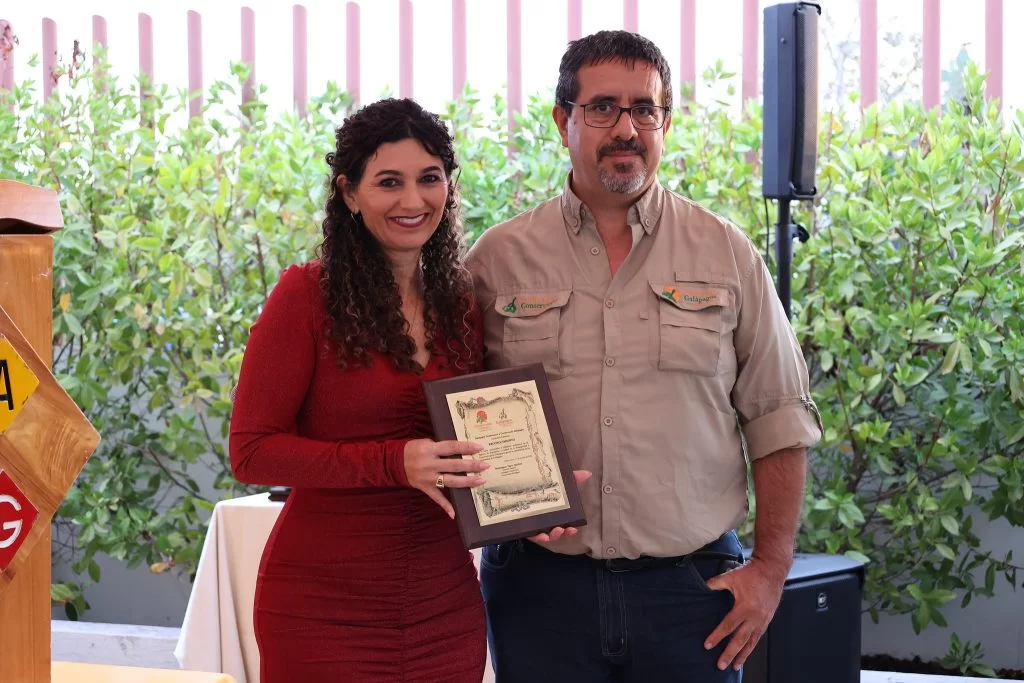
Director of Conservando Galápagos, Washington Tapia presenting an honor to ABG © Galápagos Conservancy
Galapagos Conservancy has supported the work of Cecilia Alvear Women’s Organization on San Cristobal Island (OMCA), since March 2022. This organization was started in 2001 by wives of fishermen who wanted to make a difference in their families’ lives. We do this to support the socioeconomic well-being and cultural advancement of the 24 members of this organization. Any woman within the community is welcome to join the organization. Some members are directly involved in marketing their products, while others work in handicraft production. They also receive training in expanding their product range.
Carmen Marquez, one of the founder members of OMCA, said that they have had to struggle a lot over the past 21 year to be heard by the community and to fight against the machismo which places women in a lower social position. She stated that they have made progress with determination, perseverance and effort. They are now able to improve themselves and make a positive impact on our community and families.
OMCA has partnered with Galapagos Conservancy to implement a project that provides training in bracelet weaving and fabric recycling. It also offers handicraft manufacturing and marketing skills for its members.
Fanny Munoz, who is a member, said that they have gained knowledge and experience over the past 20 years that has allowed them to enter into the labor market. This experience is now being shared by the women of San Cristobal Island. Fanny stated that the training is designed to help any woman feel her rights are being violated.
Galapagos Conservancy support allows for the maintenance and repair of a boat. This boat can be used to sell handicrafts made by OMCA members. Carmen explained that the boat used to sell our handicrafts has seen a lot of wear and tear over the years. But, thanks to the Galapagos Conservancy’s support, the crew was able to complete all necessary work to make the boat new for all members.
We will achieve gender equality and economic growth by investing in women’s economic empowerment. Galapagos Conservancy supports the efforts of 24 OMCA members, who play a vital role in the Galapagos Islands’ economy.
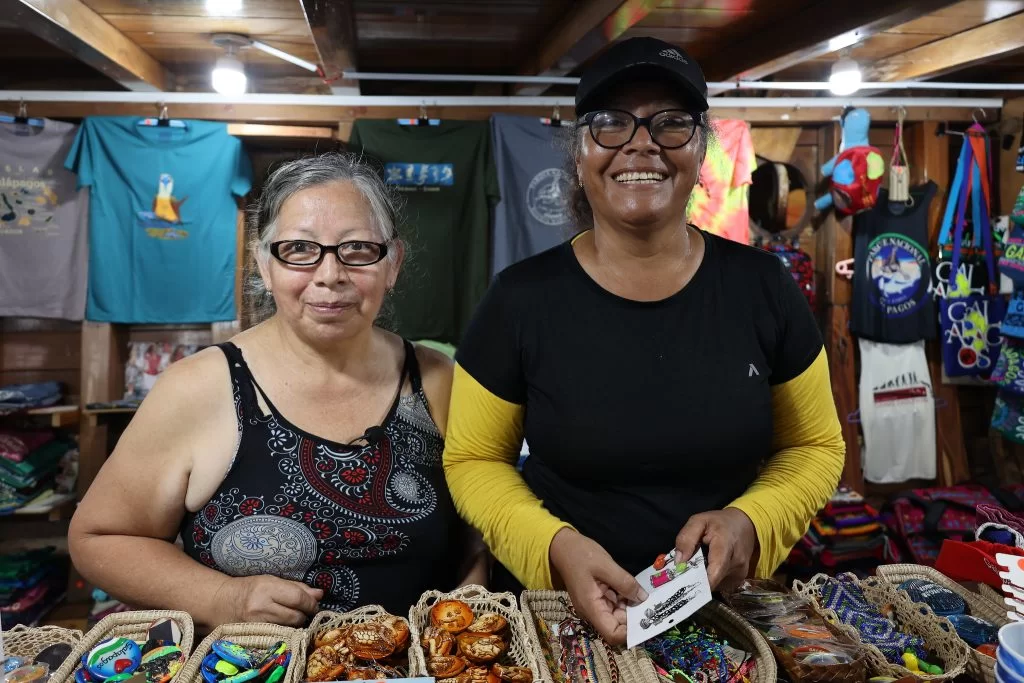
Members of OMCA Women © Galápagos Conservancy
Ivonne Torres, Conservation Center Coordinator, describes the Conservation Center’s purpose as an area for inquiry and learning about Giant Tortoises history and current status. She also provides information about conservation programs for this famous species. Ivonne also spoke about how volunteers and she work with local youth to raise awareness about Galapagos conservation. She shared that children and students from universities often visit her to learn more about the difficulties we face in protecting Galapagos biodiversity.
Dr. Diego Paez is a professor at the College of Biological and Environmental Sciences of the Universidad San Francisco de Quinto. Students receive direct information from conservationists during their interpretive visits to The Conservation Center. He said that students will be able to better see the work being done in caring for Galapagos and they will eventually take over conservation efforts [in the Islands].”
Galapagos Conservancy provided training for university students in interpretive communication skills. They participate in recreational activities every Friday as part of their community outreach internships. This is to help revitalize Charles Darwin Avenue.
Ivonne believes that didactic games that stimulate or encourage learning are useful educational tools. “We have used traditional games like hopscotch, dice, and other similar games to teach conservation through questions, answers, and that is part of our conservation education program.”
The Galapagos community is essential in protecting one of the most beautiful and well-preserved archipelagos in the ocean. In recent years, society has had a greater impact on the environment due to increased natural resource consumption and waste generation. This negatively impacts ecosystems. To ensure the Archipelago’s sustainability, it is crucial to provide environmental education for youth.
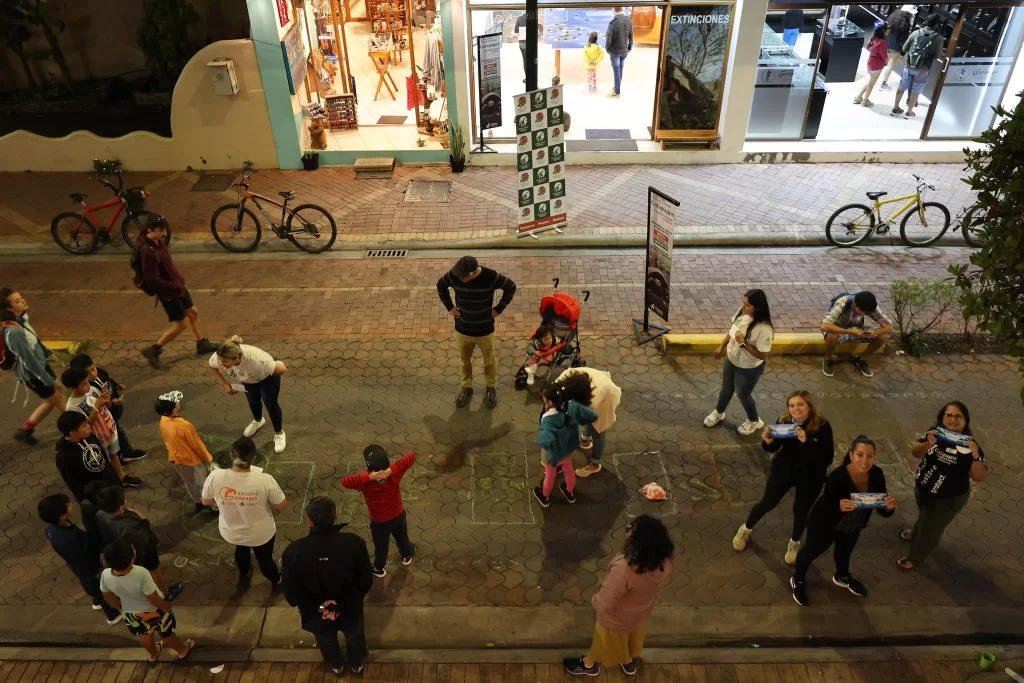
Conservation Center interactive games on Friday nights © Galápagos Conservancy
The Symbol Of Hope Hall is located on “La Ruta De la Tortuga”, an interpretive trail of the Galapagos National Park Directorate. Galapagos Conservancy funded the refurbishment. It was done under strict guidelines set by George Dante, the expert taxidermist responsible for Lonesome George’s taxidermy process that lasted nearly three years.
Lonesome George, a Pinta Island reptile, is still a very popular name ten years after his passing. Washington Tapia (General Director of Galapagos Conservancy) led the process. He stated that every effort was made to preserve Lonesome George’s taxidermied body, which is a symbol for conservation efforts in Galapagos.
A group of scientists from the University of California, Berkeley visited Pinta Island in 1971 and discovered the only giant tortoise to have ever lived on the island. In 1972, a new expedition was set up to Pinta to find the specimen. It was named Lonesome George and transferred to the Galapagos National Park Breeding Center. The chelonian spent the rest of his days in his new home until his death from natural causes on June 24, 2012. He left no descendants.
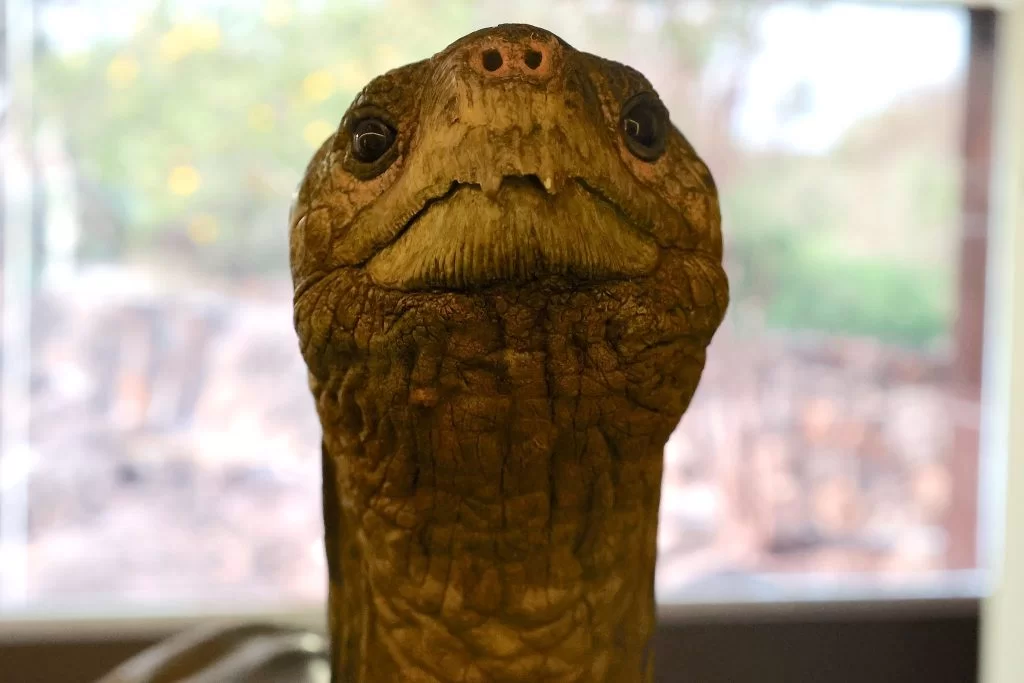
Close-up of Lonesome George © Galápagos Conservancy